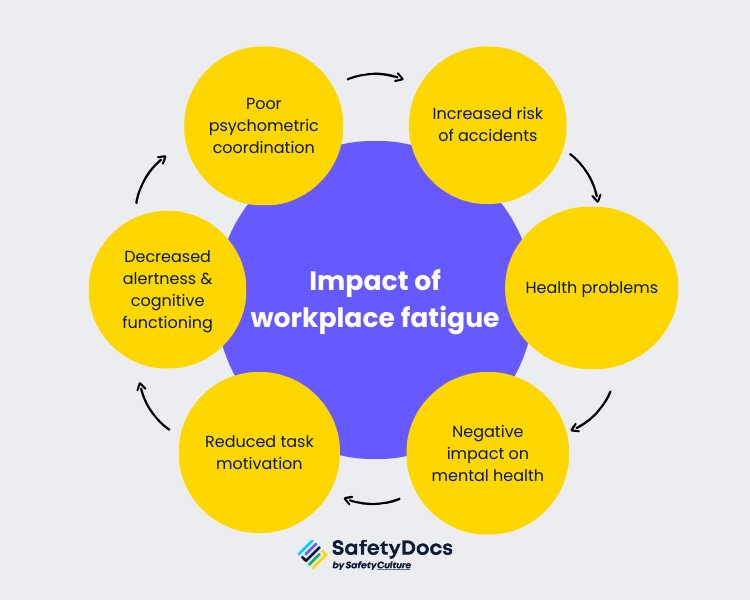Fatigued employees in the workplace are more than just a productivity concern; they represent a significant financial burden. In the United States alone, the estimated cost of fatigue-related issues surpasses $18 billion annually. Beyond the financial impact, exhausted workers also pose considerable safety risks to themselves and their colleagues. Shift workers, in particular, face a heightened risk of serious incidents when fatigued.
To effectively manage fatigue in the workplace, employers need to understand its causes and impacts. Let us delve deeper into workplace fatigue and explore strategies for a healthier, safer work environment.

Causes of Workplace Fatigue
Fatigue can be experienced in any job, regardless of physical or mental demands. It affects everyone regardless of skill, knowledge, and training. It refers to the state of feeling tired, weary, or exhausted.
In a work context, fatigue refers to an individual's physical or mental state that impairs his ability to perform tasks effectively and work safely and effectively. This can stem from factors such as sleep deprivation, prolonged wakefulness, circadian phase (time of day) disruptions, and workloads. Thus, understanding workload causes is paramount in developing effective strategies for its management.
Physical Workload
Physical workload refers to the physical demands placed on an individual while performing their duties. These job demands include repetitive tasks, heavy lifting, or prolonged standing. When an individual is required to perform physically demanding tasks for extended periods without adequate rest or breaks, it can lead to fatigue.
Workers who experience high physical workload, like those in the construction or manufacturing industries, are at a higher risk of fatigue-related accidents and injuries. Their bodies are pushed to the limit, making them more susceptible to mistakes and errors.
Mental Workload
In addition to physical workload, mental workload also plays a significant role in causing fatigue. Mental workload refers to the cognitive demands placed on an individual's brain while performing tasks. This can include decision-making, irregular working hours, and coworker relationships.
Jobs that require high levels of mental workload, such as air traffic controllers or emergency responders, can be mentally draining. When an individual is constantly required to make quick decisions or process large amounts of information without sufficient rest periods, it can result in reduced attention span, decreased accuracy, and increased feelings of physical exhaustion.
Issues like poor communication within the organisation, lack of support from colleagues and management, and workplace conflicts also contribute to an individual's mental workload.
Furthermore, technology has greatly impacted the cognitive demands placed on individuals in the workplace. With the constant use of computers, smartphones, and other devices, employees are expected to constantly process and respond to a high volume of information, such as an influx of emails.
Environmental Workload
The work environment also plays a significant role in causing fatigue in an individual. Factors such as noise, temperature, vibration, and lighting can all impact one person's ability to concentrate and perform tasks efficiently. For example, a noisy open office layout can distract and decrease productivity.
Jobs that require working in extreme environmental conditions often, such as high temperatures or loud industrial settings, are examples of high environmental workloads. These environments create physical discomfort and can cause mental and emotional fatigue.
Workers Prone to Fatigue
Aside from the jobs mentioned above, workers in Australia at high risk of fatigue include those in specific occupations and industries where factors contributing to fatigue are prevalent. Some of these workers include:
- Shift workers, like nurses, doctors, and emergency services personnel
- Transport workers, such as truck drivers, pilots, and train operators
- Night workers, such as security guards, hospitality workers, and factory employees
- High-stress workers, such as police officers and firefighters
- Fly-in fly-out (FIFO) workers in mining, oil and gas industries
- Drive-in, drive-out workers (DIDO) in remote areas
- Construction workers and other manual labourers
- Hospitality and service industry workers, especially those working long hours or irregular shifts
- Seasonal workers
- On-call and call-back workers
- Emergency service workers
- Legal professionals and IT consultants, especially those working on billable hours

Impact of Workplace Fatigue
Fatigue adversely affects workers’ physical and mental health, productivity, and safety in the workplace. It can result in a variety of adverse outcomes., including:
Increased Risk of Accidents
Fatigue has been linked to increased health and safety risks, with tired workers more likely to make mistakes or have slower reaction times to critical tasks. This poses a danger not only to the individual but also to their coworkers and the overall safety of the workplace.
Health Problems
Long-term fatigue can lead to various health issues such as obesity, diabetes, heart disease, and mental health disorders like depression and anxiety. This is because when the body is constantly fatigued, it becomes more susceptible to illnesses due to a weakened immune system. Chronic fatigue can also lead to weakened muscles and bones, making individuals more prone to injuries.
Negative Impact on Mental Health
Prolonged periods of fatigue can also significantly impact workers' mental health. It can lead to increased stress, irritability, mood swings, and even depression or anxiety. This not only affects the individual's well-being but can also create tension in the workplace and impact relationships with colleagues.
Moreover, fatigue can lead to burnout, where individuals feel emotionally exhausted and disconnected from their work. This can result in a lack of motivation, disengagement, and ultimately decreased job satisfaction.
Reduced Task Motivation
An individual experiencing fatigue may struggle to stay motivated and focused on their various work-related tasks. This can result in reduced productivity, poor-quality work, and increased errors or accidents.
Decreased Alertness and Cognitive Functioning
Fatigue impairs the brain’s ability to process information efficiently. This can impact decision-making abilities, reaction time, memory retention and overall cognitive functioning. For instance, when working with machinery or driving vehicles, a fatigued individual may struggle to make quick and accurate decisions, putting themselves and others at risk.
Poor Psychometric Coordination
Fatigue can also impair cognitive function, including coordination and decision-making abilities. This can be especially dangerous in high-risk jobs such as operating heavy machinery or driving vehicles. A fatigued worker may have a slower reaction time and decreased focus, which can lead to accidents and injuries.
Chronic Fatigue Syndrome (CFS)
While occasional tiredness is normal, chronic fatigue that persists over time can indicate a more serious issue. Chronic Fatigue Syndrome (CFS), also known as Myalgic Encephalomyelitis (ME), is a complex and debilitating disorder characterised by extreme fatigue that cannot be explained by any underlying medical condition. Symptoms worsen after physical activity, like exercise, or mental effort that don’t improve with rest or sleep.
CFS can affect individuals of all ages, ethnicities, and backgrounds. Studies suggest that between 0.4-1% of the Australian population grapple with CFS, translating to potentially 250,000 living with this condition.

Fatigue Management
Given the impact of fatigue mentioned above and before it gets serious, workplaces and individuals must take steps to manage and prevent its onset. Here are some steps to help you deal with fatigue in the workplace:
1. Comply with Regulatory Requirements
In Australia, there are several regulatory frameworks for fatigue management across different industries:
- Heavy Vehicle Transport Industry: Fatigue regulations apply to heavy vehicles subject to fatigue management, such as those with a Gross Vehicle Mass (GVM) exceeding 12t, combinations surpassing 12t GVM, buses intended for more than 12 adults and weighing over 4.5t, and trucks with a GVM over 12t that have additional attachments.
- Aviation Industry: Civil Aviation Order 48.1 Instrument 2019 outlines new fatigue management rules for flight crew in Australia, effective from July 2021. The rules include obligations for flight crew licence holders, air operator certificate holders, and Part 141 certificate holders to manage fatigue risks in their operations.
- Rail Transport Industry: The Office of the National Rail Safety Regulator (ONRSR) has developed a Fatigue Risk Management Guideline to help rail transport operators manage fatigue-related risks associated with rail safety work.
2. Exercise Your WHS Duties
Who has work health and safety (WHS) duties for fatigue risk management in the workplace? According to the model WHS laws, workplace employees must manage fatigue-related risks. This includes employers, managers, supervisors, and workers.
Responsibility as a PCBU
As a person conducting a business or undertaking (PCBU), you must prevent fatigue and place effective control measures as part of your work health and safety (WHS) duty. This includes ensuring that your workers are not working excessive hours or taking on tasks that could lead to fatigue. You must also provide a safe work environment and ensure policies and procedures are in place to manage fatigue risks.
Responsibility as a Worker
Workers are also responsible for managing their fatigue and reporting any concerns or hazards that may contribute to it. This includes being aware of their work hours and taking appropriate breaks. Workers must also follow any fatigue management policies or procedures put in place by the PCBU.
3. Prioritise your Workload
One of the main reasons for experiencing fatigue in the workplace is having an overwhelming workload. Identify your tasks and prioritise them based on their urgency and importance. Communicate with your supervisor if you feel your workload is too much for one person to handle. This can help find a solution, such as delegating tasks or extending deadlines.
4. Provide Adequate Breaks and Rest Periods
Sitting at a desk all day can be physically and mentally exhausting, increasing fatigue levels. To combat this, make sure to take regular breaks throughout the day, even if it's just for a few minutes. Along with giving yourself time to rest, use these breaks to move around and engage in physical activity.
Additionally, taking full advantage of your rest periods outside of work is essential. Make sure to get enough sleep each night and use weekends or days off for relaxation and rejuvenation. This will allow you to return to work feeling refreshed and more productive.
5. Promote a Healthy Work-Life Balance
Offer flexible work arrangements, promote regular exercise, and provide resources for stress management and relaxation. Encourage employees to use their vacation time and avoid overworking themselves. A healthy work-life balance can lead to increased job satisfaction, improved mental health, and lower rates of burnout.
6. Offer Employee Support Programs
Employers can support employees struggling with fatigue by offering access to employee assistance programs (EAPs) or other mental and or physical health resources. These programs can provide confidential support and counselling to help employees cope with stress and improve their well-being.
7. Incorporate Technological Solutions
Employers can also utilise technological solutions to help manage employee fatigue. This can include fatigue monitoring software, wearable devices that track sleep patterns, or even scheduling software that helps distribute work evenly among employees.
These technologies can provide valuable insights into an employee's level of alertness and allow for adjustments to be made in real time. They can also help identify potential problem areas or high-risk tasks requiring additional support or resources. Furthermore, technology can also aid in creating a more flexible work schedule for employees. With the rise of remote work and virtual team collaboration, employees may have more control over their working hours and location.
8. Implement Policies and Procedures
Safety policies and procedures should be implemented to help prevent fatigue-related accidents.
This includes:
- Conducting risk assessments and identifying potential hazards in the workplace
- Establishing guidelines for safe working hours and breaks
- Ensuring proper training is provided for all employees on fatigue management techniques
- Encouraging open communication between employees and managers about workload and scheduling concerns
- Setting limits on work hours and mandatory breaks to promote rest and recovery
- Encouraging employees to report any fatigue-related symptoms or concerns
- Implementing a buddy system for tasks that require high levels of alertness
- Reviewing control measures placed
By implementing these policies and procedures, employers can create a safer work environment for their employees and reduce the risk of accidents caused by fatigue.
Manage Policies and Procedures With SafetyDocs
With fatigue being a significant contributor to workplace incidents, it is crucial for organisations to effectively manage and monitor their policies and procedures.SafetyDocs by SafetyCulture offers a comprehensive solution for managing safety policies and procedures, including fatigue management guidelines.
Our library of ready-to-use templates can help organisations easily create and implement policies and procedures related to fatigue management. These templates are fully customisable, allowing organisations to tailor them to their needs and requirements.
Browse our safety documents library and find templates for risk assessments, incident reporting and fatigue management plans.
- Workplace Fatigue Management Plan
- Workplace Fatigue Risk Assessment Form
- Light Vehicle Driver Fatigue Management Form
- Psychosocial Hazards Policy
Don’t let fatigue become a safety hazard in your workplace. Contact us to learn more about our safety document templates and how they can help improve your organisation's safety.
Our team of experts is dedicated to providing accurate and informative content. Craig Cruickshank, our senior HSEQ advisor at SafetyDocs by SafetyCulture has reviewed this blog post to ensure the highest level of quality.
Learn more about Craig's work on LinkedIn for more industry insights.
Available for instant download and supplied in fully editable MS Word format for use in your business.
Please note that the above information is provided as a comment only and should not be relied on as professional, legal or financial advice.
Share This Article
